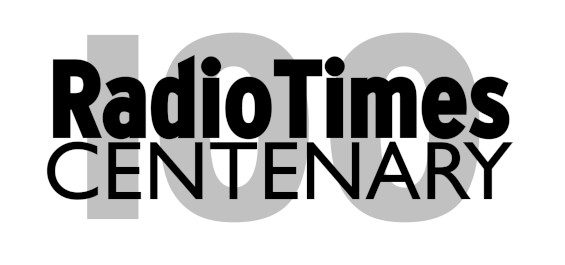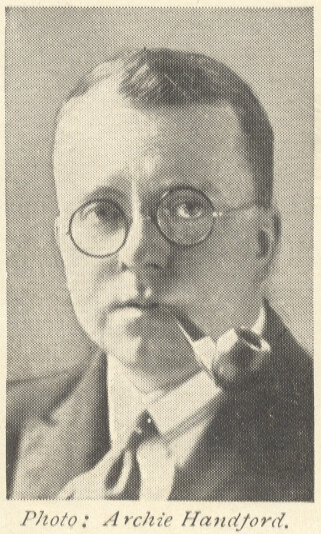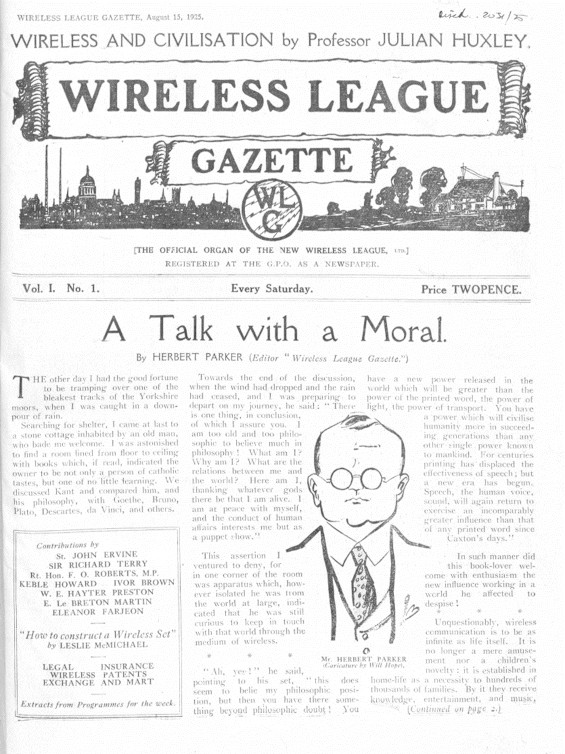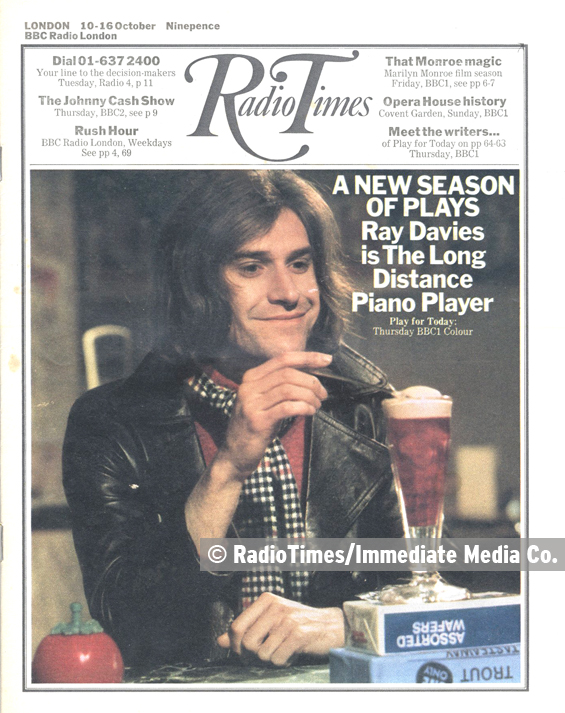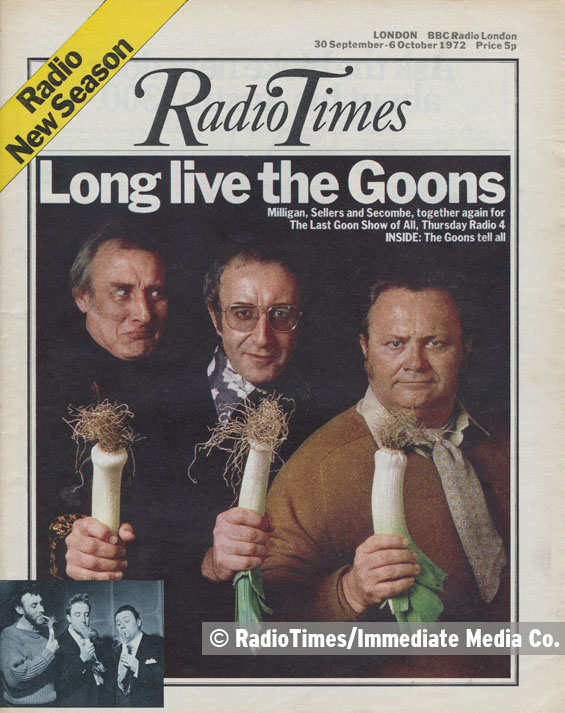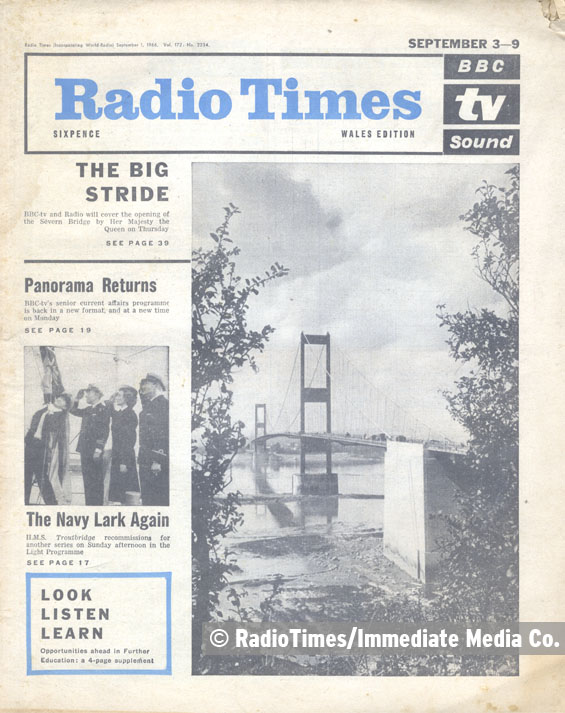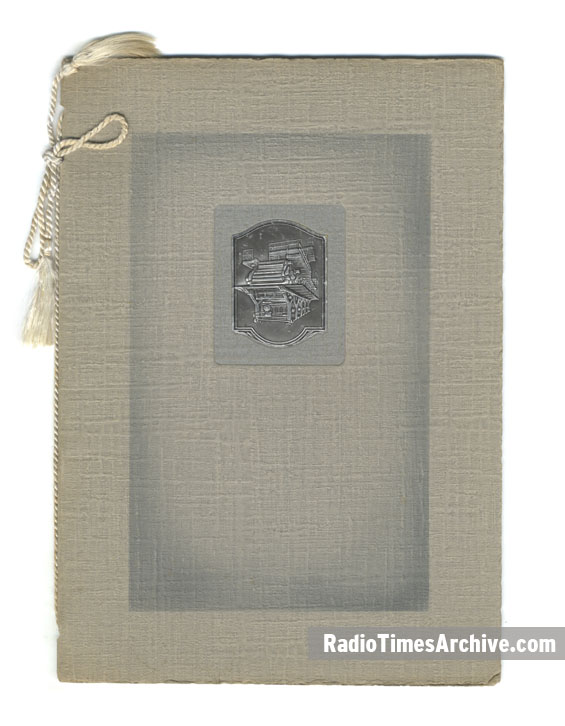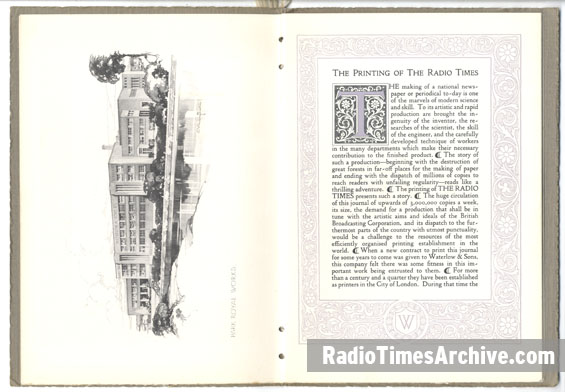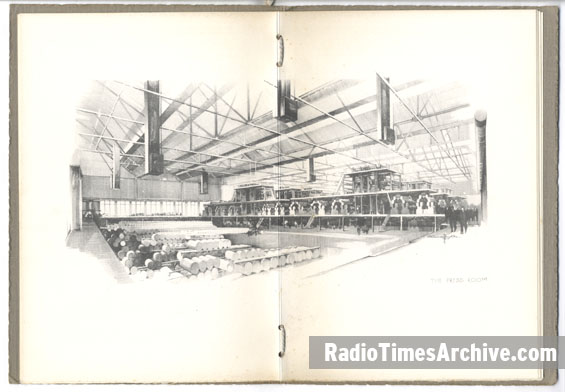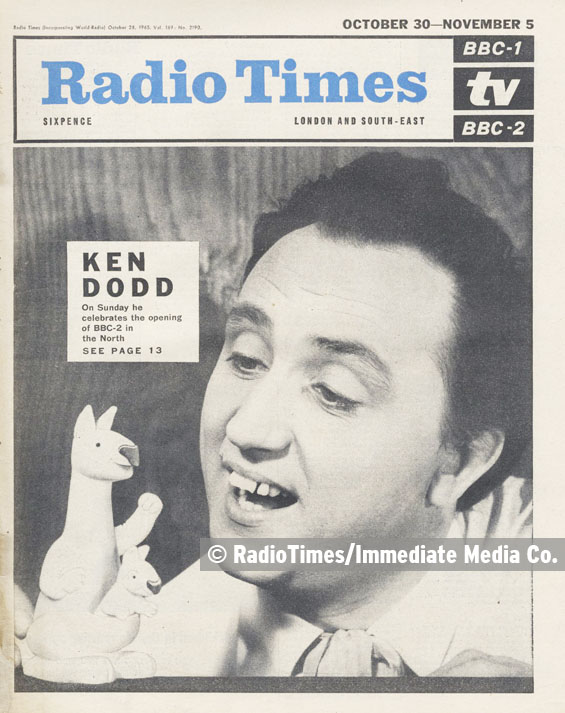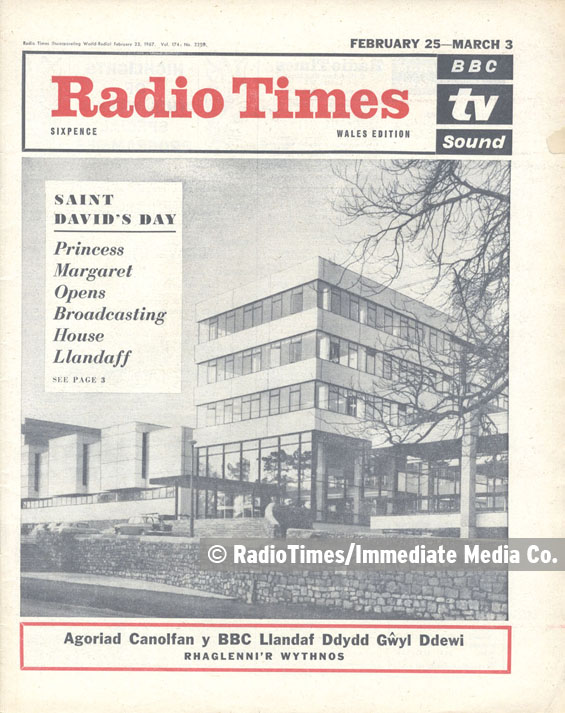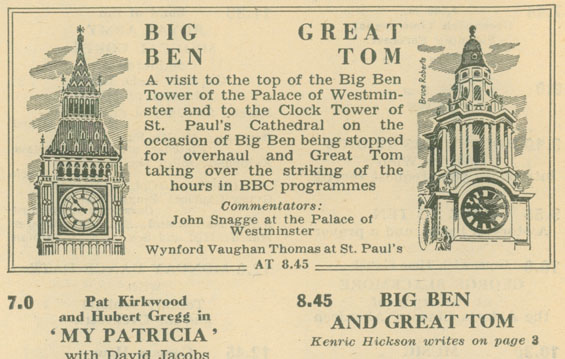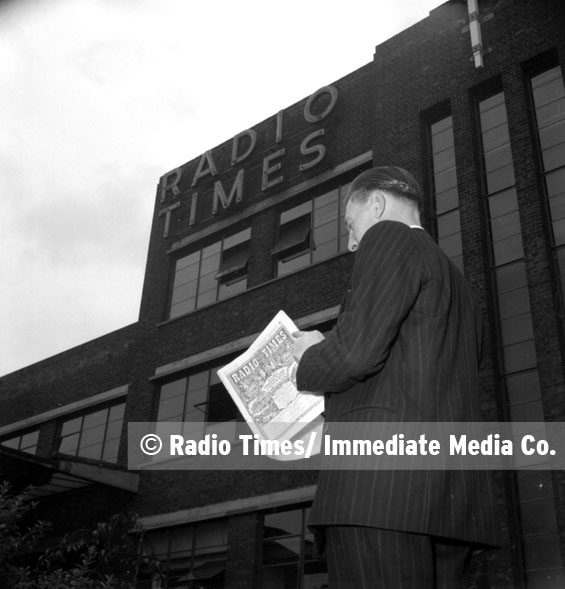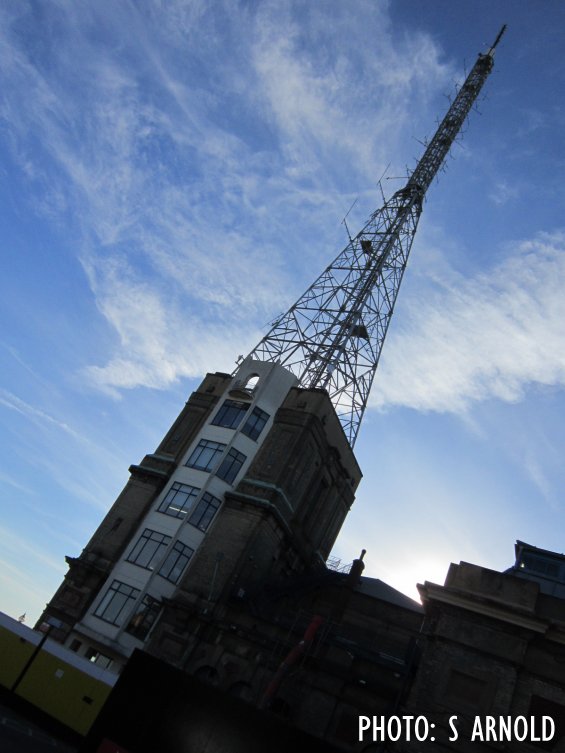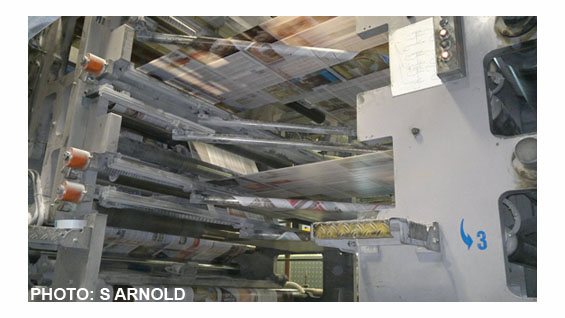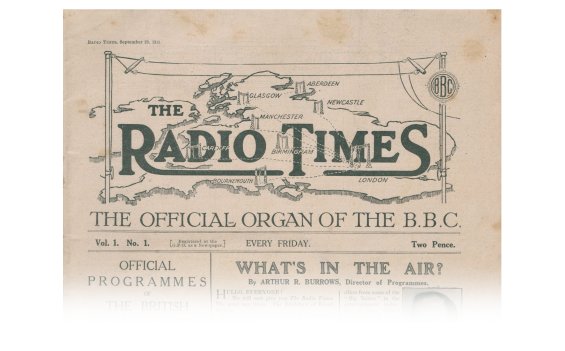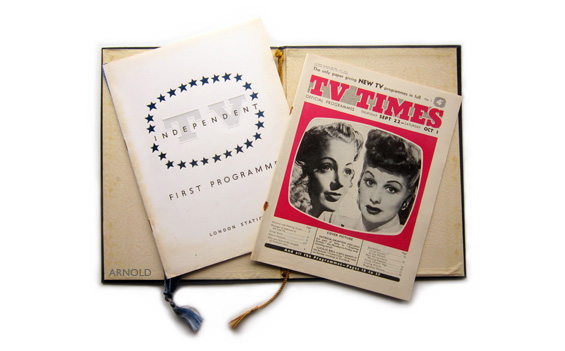Happy Birthday Radio Times24 September 2023
100 years ago this week, work was underway to get the very first issue of the Radio Times to press and out to the newsagents. This was a result of the Newspaper Proprietors' Association wanting to charge the British Broadcasting Company the advertising rate for insertion of their daily programme (schedules) in the papers as they concluded that it was to publicise the BBC who were, at that time, a company, albeit not making much money. Reith refused, there followed a very short embargo with some papers very reluctant to follow the edict of the organisation they belonged, at the end of which it was agreed that the schedules would be included without charge for a further 6 months when it would be reviewed. Reith didn't waste time and set the ball in motion for their own publication. In the 10th anniversary special of the Radio Times (issue 522, 1-7 Oct 1933), Leonard Crocombe, credited as the first editor of the Radio Times, had this to say: YOUR Radio Times began, for me, with the tinkle of my 'phone bell one summer morning in 1923. The mellifluent tones of my friend, Arthur R. Burrows, then Director of Programmes, spoke to me : would I lunch with him that day ? he had something most important to discuss. We met at Simpson's. The important matter that Burrows wished to discuss was the scheme by which my employers were to publish THE RADIO TIMES in collaboration with the B.B.C. I was then, as now, the editor of Tit-Bits. So I hurried back to the office, sought the ear of Big Business, and registered my own enthusiasm. A few weeks later I returned from a holiday, with my mind full of my own job, to be told that I was also the Editor of THE RADIO TIMES-with a colleague to look after the policy end for the B.B.C. ; moreover, it was essential that we should have the first number ready for press in seven days. And, by Saint Caxton, we did it! It is a wonderful story, and has become the official account of events, but it doesn't quite hold up to detailed scrutiny. Mention is made of a colleague at the BBC end, and Asa Briggs, in his Official History of the BBC, gives him a name, Herbert Parker.
In May 1923, Reith gave instruction for 'the appointment of an individual to deal with propaganda and the production of a magazine', and Herbert Parker was that appointment. An invitation to tender for the production of a magazine was put out soon after. By the end of July 1923, George Newnes Ltd. were the only party really interested on the terms that the BBC required and this fits with the call from Arthur Burrows to Crocombe. Mid-September, Reith was contacted by the National Association of Radio Manufacturers who were representing the smaller shareholders of the BBC to ask if the subtitle of the publication should be changed from 'The Official Organ of the BBC' to 'The Official Journal' as it was less formal and more descriptive. Reith passed the comments to Parker, agreeing with the NARA comments. This puts Parker in place and dealing with the make up of the magazine before the week which Crocombe returned from holiday and suggests he had a bit more control that just passing on programmes and information. Burrows himself is more forthright in his autobiography, The Story of Broadcasting: Mr. Herbert, the B.B.C. editor of the Radio Times, can claim perhaps a unique position in British journalism. There is no other instance in the history of periodicals where a weekly publication has grown within a year, by public demand, and intrinsic value only, to a circulation for each issue of well over half a million copies. Once there is a name to search for, references start to appear. By the end of 1923, there was an article in the provincial press crediting 'Mr Herbert Parker, editor of the "Radio Times," who is not fond of the limelight' with a Christmas number among the best of the year. The journalist Filson Young in his memoirs (Part 7 - Making Airwaves 1924-30) said this about the Radio Times: This meant that it had two editors with equal power, Herbert Parker of the BBC who supplied the copy and Leonard Crocombe of Newnes (also editor of Titbits), whose job was to keep the paper in shape. This arrangement sometimes caused confusion. The question that immediately arises is why was Parker removed from history, especially as he stayed in post until May 1925. In March 1925, The Daily Express established The Wireless League - a New Association for Broadcast Listeners, and Sir Arthur Stanley announced that the Radio Association and Wireless League were joining forces to create a single strong national body to care for the interests of listeners. By 13 May, Herbert Parker was the General Secretary of the League - a simple move from one broadcasting related organisation to another. Things started to get interesting in July when there was a disagreement at the top and suddenly there were two Wireless Leagues - the original and the 'New Wireless League'. The disagreements are not disclosed in the press, but in August a new publication hits the newsstands, The Wireless League Gazette, and who should grace the cover of 'The Official Organ of the New Wireless League'? None other than Herbert Parker, Editor.
The BBC took a dim view as the magazine included detail of around half of their programmes (schedules) and sought an injunction, which was granted. The ensuing legal action set the precedent for the arrangement in schedule copyright that lasted until March 1991. Parker withdrew from broadcasting related business and opted for local politics instead (he'd been unsuccessful in the 1924 General Election, standing for the Labour Party in Richmond) having blotted his BBC copy-book and burnt bridges with The Wireless League. By 1933 he could be easily skimmed over. Editorial control rested entirely with the BBC by 1926 under Walter Fuller and Arthur Burrows had left for Geneva to become the Permanent Secretary of the Union Internationale de Radiophonie so skeletons could be left firmly in the closet. But what of Burrows contribution to the Radio Times, after all, he is pictured on the cover of the first edition and welcomes everyone to the new publication. The early years paperwork is sparse but it is highly likely that even if he wasn't editor in name, his contribution would be what is classified as that of a guest editor these days. Without wishing to take away the contribution of Leonard Crocombe I have chosen to adopt Filson Youngs description and say Parker and Crocombe were joint editors and I am going with gut-feeling over the immeasurable contribution and influence on broadcasting Arthur Burrows had by including him as a guest editor (I've currently exluded mention of any others who have had that title in recent years). Amending the timeline we now have:
* Guest editor, first edition, Arthur Burrows.
Spring Clean3 April 2021
The last year has been an awful one across the globe. As Spring arrives and there is a light on the horizon, we have taken the time to clean and update the website and start to plan out updates for the coming months and what better way to start than with the Spring Number cover, by Robert Gibbings, from April 3, 1936. Gibbings was born in Cork, Ireland, in March 1889, and studied medicine before persuading his parents to allow him to take up art. First he studied under painter Harry Scully in his home town and later at the Slade School of Art and the Central School of Art and Design, becoming an accomplished and acclaimed wood engraver. Whilst working ont he wood engravings for a book cover, the press owner became ill, and Gibbings bought the press and became a publisher. By the time he produced the artwork for the Spring Number, Gibbings had sold the the press but remained an author illustrator and as his reputation grew, he was commissioned to write and illustrate books. 1936 was also the year that we was appointed as sessional lecturer in typography, book production and illustration at Reading University. Later in life he bacame a familiar broadcaster on television and radio. He died in January 1958. With the Spring clean, links have been checked, the navigation tidied up, and the astute among you will notice some links to the right to subscribe to Radio Times, TVTimes, and the British Newspaper Archive. This website is not funded - it is a labour of love. That means a little bit of cash from time-to-time doesn't hurt and pays for the basic running costs and the luxuries in life, like the magazines that are the source of the information. Radio Times and even TVTimes are obvious inclusions, but why the British Newspaper Archive? The listings magazines concentrated on what was on and, to a lesser degree, the reception of the programmes. Newspapers can provide context and far more immediate reaction to programming, and were often more up to date than the weekly listings prepared a week in advance of publication. The past is another world, and the ability to delve into it whilst in the comfort of home, has helped retain sanity over this last year. So, if you are considering a subscription, hadn't thought about one but like the idea of your favourite magazine popping through your letterbox each week, or want to know about more about what was going on in the past, follow the links to the right, sign up, and we earn a little bit. Thanks in advance. Play For Today15 October 2019
A post by #BBCArchive spurred the latest update, On this day in 1970, Play For Today, a long running strand of single plays started, with full cover publicity. The first play was The Long Distance Piano Player with Ray Davies. St. David's Day1 March 2019
What better way to mark St. David's Day than to have The Goons - Spike Milligan, Peter Sellers and Harry Secombe - holding leeks on the front cover of the Radio Times. Published in September 1972 to promote The Last Goon Show Of All - part of a season of programmes to commemorate the 50th Anniversary of the BBC - it was an update to the earlier image showing the Goons lighting cigarettes with leeks. By the 70s no smoking policies were beginning to appear in the workplace and Radio Times took a stand in 1969 and stopped advertising cigarettes within the magazine. The Severn Bridge31 December 2018
Back in September 1966 the Radio Times celebrated the opening of the Severn Bridge by Her Majesty The Queen with a special cover (for the Wales edition, at least). It speeded up travel to and from the Principality and replaced the toll ferry with a toll road. Growing up I knew I was almost on holiday when the towers of the bridge came into view. Earlier this month the tolls were abolished (a little earlier than the end of year originally planned). Opening of Waterlows Printing Works, Park Royal, 193621 December 2018
On this day in 1936, a new chapter opened for the Radio Times. From the first issue the magazine had been printed by George Newnes, with Newnes initially supplying the editor and the BBC simply taking a cut of the profits. This later changed with the BBC having editorial control and Newnes given 10 year contract to print. By 1936, this contract was up for renewal, and in a shock, the tender was won by Waterlows. Waterlows built a dedicated works in Park Royal, North West London to print the Radio Times, World-Radio and The Listener, and 1937 saw the first issues to come off their state-of-the art Crabtree rotary presses. Before printing could begin though the works had to be opened and the occassion marked and this occured on Monday 21st December 1936. H.R.H. The Duke of Gloucester, K.G. had consented to peform the opening ceremony, but due to illness, was unable to do so and the task of formally opening the building and starting the machinery fell to Mr R C Norman, Chairman of the BBC. After the presses began to roll, curtains were drawn between the factory and the luncheon room and the great and the good then sat down to eat. A lavish commemorative booklet was prepared in advance of the event and given to the lunch guests, some pages of which are given here.
I would like to thank Julia Opposs for kindly donating the booklet to radiotimesarchive.com Sir Ken Dodd 1927-201812 March 2018
BBC2 launched, after a false start, in April 1964, but initially could only be received in London and the Home Counties, slowly expanding out as the transmitters could be built and tested. It was October 1965, over a year later, that the North region could finally get the extra channel, and who better to celebrate the launch than Hullabaloo and Custard - the mascots of the channel - and the face of the North, Liverpudlian, Ken Dodd, in this edition of the Radio Times. This wasn't Doddy's first time on the cover of the magazine, he had appeared, with others, in 1962 promoting Comedy on Parade and in a panel (cricketer Fred Truman took the main spot) in 1964, and it wouldn't be his last either as he turned up every ten years or so - quite a feat considering the changing tastes of television. St. David's Day1 March 2017
Not only it is a celebration in Wales for their patron Saint, but today is the 50th anniversary of Broadcasting House, Llandaff - featured on the cover of the Wales edition of the Radio Times in March 1967. The article inside extols the vitues of this 'fine building'. Elegantly set in an agreeable site, it affords glimpses from the office windows on the upper floor of the river Taff looking quite silvery, and an entrancing view of the tower and spire of Llandaff Cathedral. From the roof there is a commanding view of the surrounding countryside and the Channel and beyond. This modern building has in its structure a picturesque link with the traditional building practice of the locality in the effective use made in the walls of river pebbles from the Taff, contrasting sharply with slabs of marble concentrate. The only difference is that for the quantities of stones needed it was necessary for the builder to go up river as far as Aberfan. I wonder if the views available in 1967 are still the same. 50 years isn't that old for a good building, but the needs of broadcasting have changed and it is far cheaper and easier to build new and knock down old, so it is no surprise to find that its days are numbered with the site sold to Taylor Wimpey to help fund the move to a new site in Central Square. At least it has made its half-century. The Chimes of Big Ben30 January 2017
Late last year a young girl wrote to Radio 4's PM show to offer her services as the Chimes of Big Ben, as urgent repair work was needed on the Elizabeth Tower and the bell, Big Ben, would fall silent. Various articles suggested that this was only the third time in 150 year that the bell had been silent, but digging through the Radio Times, it isn't the case. On the 2nd July 1956, much was made of the fact that the bell Great Tom, housed in St. Pauls Cathedral clock tower, was taking over for two or three months, whilst Big Ben was being repaired. A mere slip of a bell at 4.5 tons (Big Ben is three times that) it is the older of the two bells, being made in 1716, and chimes differently to the familiar Big Ben. Wynford Vaughn Thomas was at St Pauls, and John Snagge was at Westminster to feature the handover of responsibility of chiming to the World. The article also mentions that this wasn't the first time that Great Tom had come centre stage. Back in 1934, again when the Westminster clock was undergoing repair, the chimes came from St Pauls. I can only assume that the understudy performance was so good that no-one really noticed the difference. Happy New Year!1 January 2017
There were big changes afoot for the Radio Times in the mid 1930s. The magazine had originally been edited and printed by Newnes and Co. with a profit share arrangement until 1926, when editorial control was moved to the BBC. Newnes continued the printing and presumably had a 10 year contract to do so, but towards the end of this Waterlows offered a more attractive tender, and a purpose built factory was established at Park Royal, opening 1st January 1937 - 80 years ago today. Offering state of the art presses, larger capacity, this would be the printing home of The Radio Times (and The Listener) until the mid 50s when it reached full capacity, even after doubling the number of presses, and another factory was opened at East Kilbride to handle the Scottish and Northern editions. Even so, it still handled the lions share of the print run for the entire lifespan of the hot metal process and into the photopolymer plate era. The presses finally came to a standstill in the mid 80s when printing moved over to web-offset when the days of smudgy greys on absorbant newsprint were replaced by clean blacks on white paper and more colour thrown in throughout. The building still stands and is in use daily, albeit for a different purpose entirely. The current owners are aware of the heritage of the site and are planning to embrace it. HAPPY 80th BIRTHDAY, BBCtv2nd November 2016
+ + + STOP PRESS! + + +7 April 2016
Quite literally it would seem. It has been announced that the printer of the Radio Times has changed with immediate effect and the 80 year old involvement of the company Waterlow and Sons (through its immediate successors) has come to an end. Waterlow and Sons gained the printing contract in the mid 1930s and constructed a new works at Park Royal to handle the increasing circulation of the magazine, and the first editions came off the presses in January 1937. By the mid 1950s further expansionw as required and another plant was built in the New Town of East Kilbride near Glasgow, with editions for Scotland, Northern Ireland and the North of England coming off the presses in August 1956. Waterlows, like many other major printers, became part of the British Printing Corporation, but the name lived on. Rupert Maxwell had gained control off the BPC in a 'dawn raid' and by the mid 1980s the newsprint presses were replaced with web offset: The Park Royal site was closed, and East Kilbride moved a little way up the road to a new home and new presses. Printing was, by this time, spread around the BPC group (now BPCC, as Maxwell had added Communications to the name) and it wasn't long before BPCC became the Maxwell Communication Corporation. After Maxwell came to a mysterious end, it was evident that his business practices were less than satisfactory, and administration followed, with the company broken up and a management buy-out created Polestar. Having printed the Radio Times for the last 25 years, Polestar moved the production from their Leeds site (what was Petty and Sons) to a new facility in Sheffield at the end of 2014, and it is there that the last Polestar edition came off the presses - with the late Ronnie Corbett gracing the cover. The Wyndeham Group have taken over the responsibility of the 3/4 million copies per week and will printing it at their Peterborough site. HAPPY 92nd BIRTHDAY, RADIO TIMES
Isn't it always the same, birthdays don't come along for ages, then two appear at once! Not quite a milestone number, although in my mind anything after 90 is a milestone, the Radio Times turns 92 today (28th September), the first edition (available as a PDF here) being published in 1923. A lot has happened in that time, including competition, but it still has a reasonable circulation (around 712K for Jan-Jun 2015*). It's commercial counterpart (60th last week - see below) is less than a third that (213K, same period*). Happy Birthday Radio Times, long may we see you on the shelves. (*source: ABC) HAPPY 60th BIRTHDAY, TV TIMES
Yes, this is the Radio Times Archive, and yes, that is a (cough) TV Times, but it isn't every day that you turn 60, and on this day in 1955 the very first edition of the TV Times was sitting snugly next to the Radio Times on newsagents shelves in readiness for the broadcasting revolution that was to happen, to the 100,000 or so people in the London area anyway, a couple of days later - commercial television, or ITV. Since 1922 the BBC had had a monopoly on broadcasting in the UK, and there was very little competition from anywhere else - Radio Luxembourg was the most serious. Television was in the accendence - the Coronation a couple of years earlier certainly did a lot to make people aware of the box in the corner of the room, but it was still a single national service and not available to the whole country by the time ITV was announced, and that was to be regional. Outwardly the BBC was stoic, why would a brash upstart affect them? Inwardly they were concerned. Staff had left with enthusiasm for a new service and wanted to try out new ideas that an established and trusted (some might say stuffy) organisation wouldn't let them. The BBC were so concerned that they took action by killing off a main character in a hugely popular radio soap, The Archers. Grace Archer was to die shortly before Associated-Rediffusion, serving the London region, took to the air on the 22nd September. There were sombre faces up and down the country, and what promised to be a party atmosphere in some London homes welcoming to new, was more like a wake, mourning the loss of an old freind. The opening ceremony was from the Guidhall, London, and began at 7.30pm with the Halle Orchestra and a commentary by John Connell - guests were seen arriving from a start of braodcasting at 7.15pm. About 500 of the great and the good were there, including Sir Ian Jacob, Direcetor General of the BBC! Speeches by The Lord Mayor Of London, The Postmaster General, Dr Charles Hill, and Sir Kenneth Clark followed, and then the real programmes began: 8.00 VARIETY The franchise for the London station (channel 9) was split between two companies, Associated-Rediffusion on weekdays and Associated Broadcasting Company at weekends. The Independent Television Authority (ITA) didn't want to hand monopolies of potentially huge earning capacities to any one station so split some franchises in this way. The only one to survive in this form was the London franchise, with Thames and LWT sharing for the majority of the life of regional ITV. Associated-Rediffusion, a joint venture mainly between British Election Traction and its subsidiary Broadcast Relay Services Ltd, and Associated Newspapers, took the former Air Ministry building, Adastral House, on Kingsway and renamed in Television House. It was far bigger than their own needs, so it was easy to house the news service ITN, and the offices of the TV Times - making it a one stop shop of ITV. The Associated Broadcasting Company didn't actually last long under that name as The Associated British Corporation who ran a large chain of cinemas under the ABC initials, forced a change, so a few weeks later Associated TeleVision Ltd (ATV) was born. ATV also held the Midlands weekday franchise which began the following February. So the first edition of the TV Times was actually less than half filled with times for television. A-R had got in first with the Thursday launch, but ATV had two full days of transmission rather than the 1 and a bit. Without the need to include radio or regional information, the TV Times was far more spacious - two wide columns compared to the normal 4 of Radio Times. There was spot colour (a pinky red) on the cover of the TV Times - the Radio Times had last seen spot colour on the masthead in 1944 when the red ink disappeared, and apart from the yellow paper stock for the Coronation Issue, wasn't to see spot colour again until 1958. Like ITV, TV Times was bold, brash, and muscling in on established territory. The BBCs answer was to keep calm and carry on, and essentially ignore the existence of ITV. This became increasingly difficult as regional stations appeared, but the BBC was unified across the country, whereas ITV was almost a loose affiliation of warring tribes, each wanting to protect its own advertising revenues, get value out of its programming, and in the first few years at least, try to survive. The TV Times as a single magazine for the entire ITV network wasn't to arrive until 1968. Inevitably with many of the original regional company shareholders being newspaper groups, there were several listings mags: TV Times, The Viewer, and Television Weekly to name a few, TV Times was definitely the first and the one that endured. Happy Birthday TV Times! WALTER FULLER: THE MAN WHO HAD IDEAS
I was fortunate to be sent a copy of this fascintating volume covering the life of the second editor of the Radio Times, Walter Fuller and his family. I make a point of mentioning the latter as his life is heavily intertwined with his sisters, so the majority of the book reads more like 'The Fullers' than just a biography of the man himself. Sadly, his untimely death means that for those who are interested in his short time at the BBC and Radio Times in particular, it is only really the last couple of chapters, a small part of the book, that will hit the mark. A very in depth, and academic, read, I have to confess that when I originally tried to fit in reading the book in short snatches it was easy to get lost amongst who was who and who did what, that I quickly went back to the start and set aside quality time for it. This isn't a complaint about the book, but more an observation that most books these days are aimed at an audience with little attention spans, and something a bit meatier can be a jolt. As I say, the first two thirds of the book, whilst interesting in its own merits, covering the Fuller Sisters touring America to sing the folk songs they collected and researched, World War I and the peace and propaganda movements, and Walter's not insignificant contribution to both, is only a sideline to the story that readers here will be interested in, but it is well worth spending the time to get to know the man, his almost limitless ideas (hence the title of the book) and his ideals, as they are what made his contribution to Radio Times something special in its formative years. New technology has also been embraced with this publication, as much more than could be included within the covers is available on the associated associated website, and I found myself flitting between the printed covers and the web. For those of you unsure about buying, you can readily access the web based material, read the first 20 pages, browse the index and more. I like to think of myself as an authority on the history of the magazine, but the research behind the book has been so thorough that there are items new to me. Highly recommended. The Radio Times has been a constant companion to those listening to the radio or watching television since the first editions appeared on the News stands in September 1923. It has adapted to the many changes in broadcasting during its nearly 90 year lifespan, and has embraced new services as they arrived. This site is intended to provide a general overview of that rich history and cover some areas in much more detail. It overlaps with the BBCs own site covering their history and you are encouraged to take a look there, but not before you have explored this one a little more. |
External links
Radio TimesThe UKs oldest listings magazine - nearly 100 years old and still going strong.
BBC GenomeSearchable listings digitised from the Radio Times covering 1923 to 2009.
History of the BBC WebsiteFascinating facts and details of the UKs oldest broadcaster, incorporating all Pre-war Television material created for this website.
This website is run on donations and goodwill, but that isn't always enough. Please consider subscribing to Radio Times, TVTimes or the British Newspaper Archive via these links so we can earn a little bit of commission. Thanks.
Radio Times subscription
TVTimes subscription
British Newspaper Archive
subscription
The Radio Times word mark and logo are trademarks of Immediate Media Limited.
Downloads are for your personal non-commercial use only.
This website has been produced with the permission and support of the Radio Times and financial support from the Shiers Trust (2008, 2010 awards).
Website design: sarnold.co.uk
